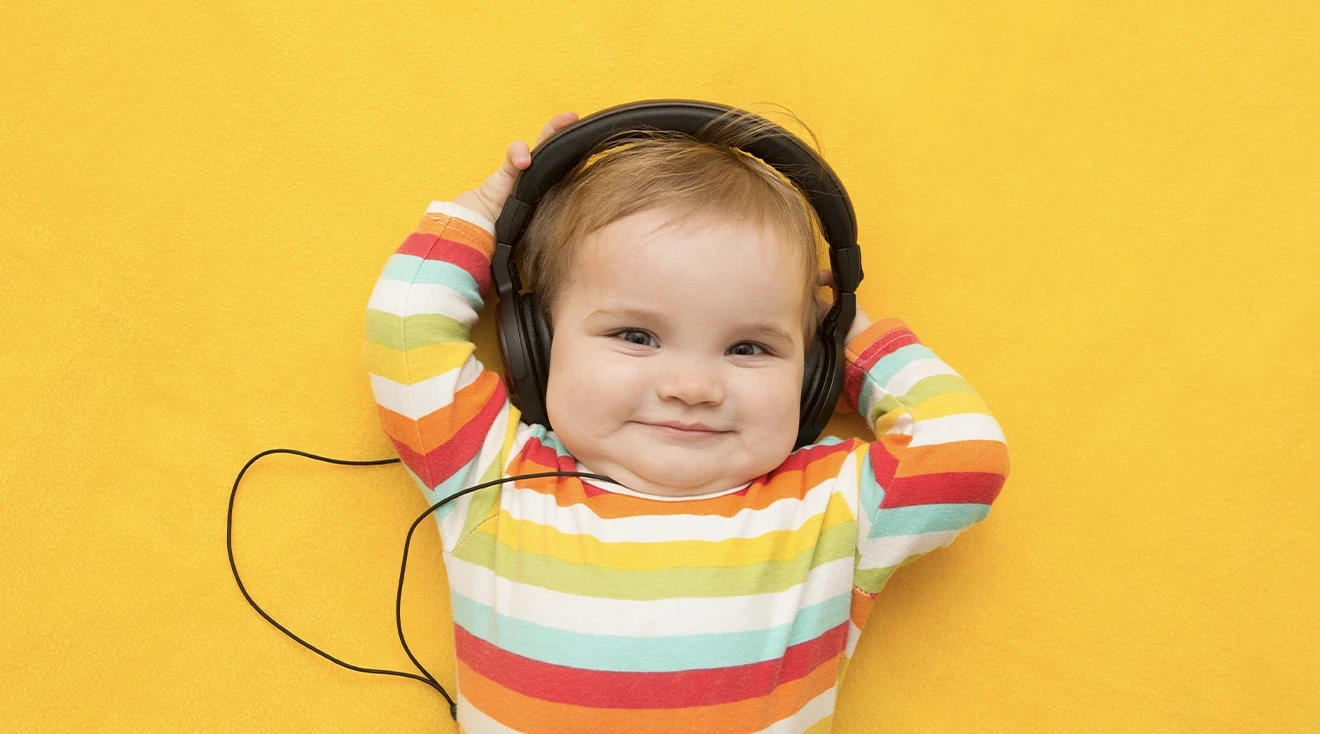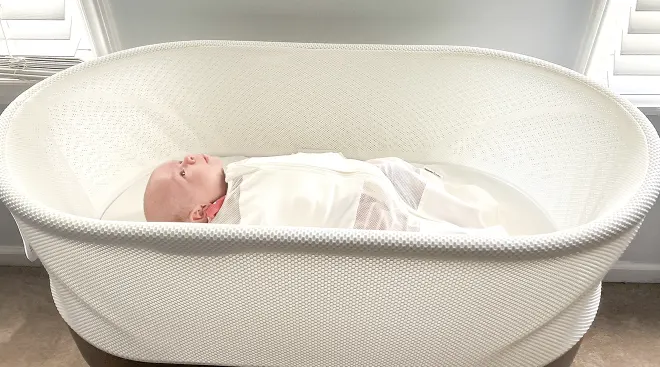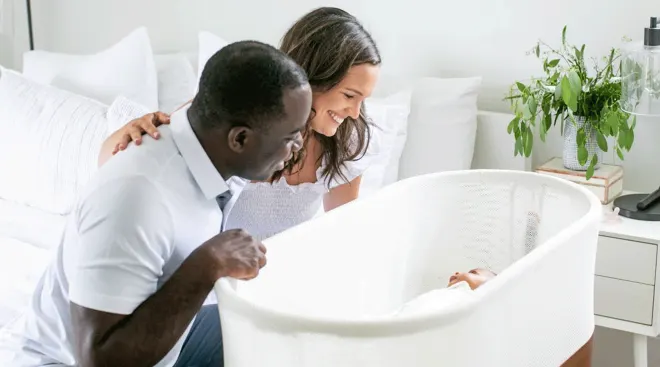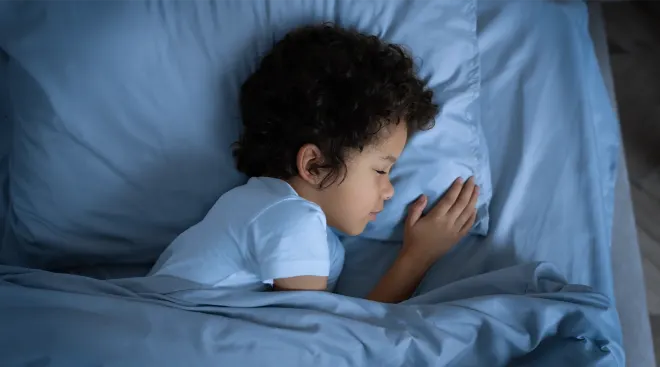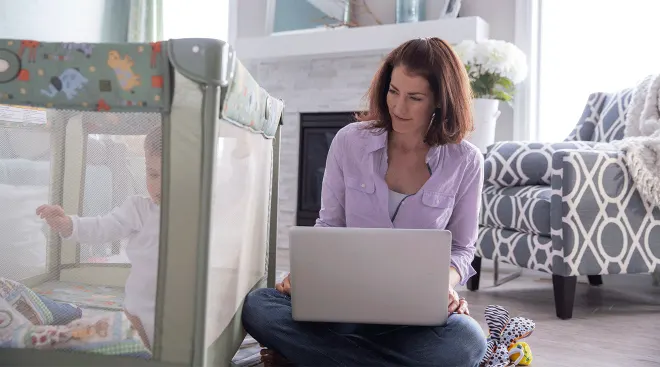5 Best Preschool and Toddler Headphones, Tested by a Mom of Three
In a nutshell:
Based on hands-on product testing, we chose iClever Kids Bluetooth Headphones BTH22 as the best overall toddler and preschool headphones, due to the safe volume limits, comfortable design and high-quality audio.
Popping in earbuds to listen to your favorite playlist or audiobook is second nature for most of us—and at some point you may choose to invest in a pair of headphones for your kiddo too. According to Michelle Neidleman Kennedy, AUD, an audiologist and tinnitus expert at Treble Health in New Jersey, appropriate headphones can help teach toddlers “safe listening habits that they will likely continue as they get older.” Some headphones for toddlers also block out ambient noise, which can be helpful at loud events or on long-haul flights. But don’t rush out and buy any old pair, when it comes to toddler headphones there’s a lot to consider. Regular headphones are too loud for sensitive little ears and may cause permanent hearing loss, plus you’ll need to factor in the fit, design and other technical features.
The best toddler headphones are equipped with audio controls designed to protect their developing sense of hearing. As a mom of four, I know that finding the right headphones for your toddler can be overwhelming. To help you narrow down your search, I personally tested seven pairs with my own toddler. Based on the testing results, we selected five of the best toddler headphones deemed safe for young children.
To find the best headphones for toddlers and preschoolers, The Bump editors conducted extensive market research and created a shortlist of top-rated toddler headphones. From there we took the following steps:
-
Over the course of two weeks, I tested seven pairs of headphones with my 3-year-old, who wore them while listening to music, playing on a tablet, running through the house and performing jumping jacks. (I also tried them on to get a feel for the overall audio quality!) Based on feedback from my kiddo, I rated the headphones from 1 to 10 using the following criteria: ease of use, volume and audio quality, comfort and fit, battery life and charging, durability, features and design and value for money.
-
We interviewed an audiologist and a pediatrician to better understand safety concerns and essential features to keep top of mind as you shop for toddler headphones.
-
Because no two children are the same, we scoured forums and message boards and read user reviews to see how these toddler headphones performed for a variety of families.
Editorial integrity is at the heart of everything we publish. Read about how The Bump develops and reviews all articles, including product reviews.
Overall best headphones for toddlers and preschoolers
- Affordable
- Two volume-limiting settings
- Foldable design
- No carrying case
- Limited colors
The iClever Kids Bluetooth Headphones BTH22 are a popular choice among parents, thanks to the safe volume limits, comfortable design and clear audio. And, with perfect 10 out of 10 scores in every testing category, these headphones stood out to me as the top choice for overall best toddler headphones.
In terms of setup, it was easy to connect the Bluetooth and we did not experience any issues with losing the connection once paired. Although these headphones were wireless, they also came with an audio cable for wired listening. At 4 feet, the audio cable was plenty long enough, and it allowed for enough slack without getting tangled or in the way. The three built-in buttons (ON/OFF, +, –) were easy for my 3-year-old to navigate, and by pressing the plus and minus buttons at the same time you can activate the volume limit—my favorite feature—which allows for the max volume to be set at a safe level of either 74 dBA or 85 dBA. Once the volume limit is set, it won't allow your child to increase it but they can still lower the volume if they want to.
At under $25, these headphones provide excellent value and I was pleasantly surprised by how well they performed despite the lower price point. They not only feel sturdy enough to handle some rough play—which seems inevitable with toddlers—but they are also comfortable and provide clear, crisp audio. The flexible headband and larger ear-pad size allowed both my 3-year-old and myself to wear these headphones for long periods of time without any discomfort and my toddler even said, “It feels like little pillows on my ears.” The cushioned ear pads also seemed to help block out some of the external noise, which was an added benefit.
Although these headphones don’t come with a carry-case for travel and lack some of the flashier features, such as active noise cancellation, I wouldn’t expect that at this low price point. The ear pads do however twist and fold inward, making them more compact for travel or storage. Plus, the audio quality was very clear and crisp.
Age rating: 3+ years | Volume output limit (dBA): 74/85 dBA | Battery life: 60 hours | Weight: 5.8 oz.
Our product tester says: “The audio is extremely clear and I especially appreciate that the volume-limiting feature allows you to limit the sound to 74 dB, which is less than the 85 dB limit of most of the headphones we tested."
Best toddler and preschool headphones with additional features
- Three volume-limiting settings
- Audio sharing capabilities
- Built-in microphone
- Includes soft travel bag
- Shorter charging cable
- Built-in buttons can be confusing for children
At $50, BuddyPhones Play+ are middle of the pack when it comes to price, but the headphones are packed with features that set them apart. First and foremost, these toddler headphones have three audio output settings that can be controlled by parents: a 75 dBA toddler mode, a 85 dBA kids mode and a 94 dBA travel mode. (It’s important to note that anything over 85 dBA is deemed unsafe for children.) I appreciate the lower limit of the toddler mode, as most headphones we tested only limit the volume to 85 dBA, which is far too loud for my toddler, but I wish it was possible to reduce the volume further. Aside from the three levels of parental control, these headphones feature a built-in microphone, a voice-enhancing study mode and BuddyLink, which is a daisy-chain system for audio sharing.
The microphone is great for distance learning as is the “StudyMode” feature. Although the audio in the standard setting was clear and would be great for a child, this setting produced more crisp vocals than the standard setting. However, I noticed that the headphones glitched and the music cut out for a couple of seconds, while in study mode. The headphones are wireless, but also come with a 51-inch audio cable for wired listening, as well as BuddyLink which allows two kids to listen to the same device by connecting their headphones with the audio cable. My 3-year-old and 6-year-old loved this feature and enjoyed playing on the tablet together while each wearing their own set of headphones. While the actual audio cable was long enough, the USB-A to USB-C charging cable was only 9 inches—one of the shortest charging cables I tested. Depending on the location of the outlet or charging device, it was too short at times, but since this is a standard charging cable size, we were able to use other charging cables instead.
The headphones also come with four sticker options to allow for your child to customize the outside of the ear piece. Although I didn't expect my 3-year-old to be particularly excited about the sticker options, he was thrilled to see his chosen stickers on the headphones. Overall, I felt like the design was child-friendly with regards to the included stickers for customization, the BuddyLink feature and the built-in volume controls. However, my toddler wasn’t able to control the settings using the built-in buttons as they rely on holding certain buttons for different amounts of time. Luckily, he could do nearly all actions from the tablet or device he was using instead, so this wasn't a deal breaker.
Age rating: 3+ years | Volume output limit (dBA): 75/85/94 dBA | Battery life: 20 hours | Weight:5.2 oz.
Our product tester says: “The audio quality, volume limits, Buddy-link and sticker customization made these headphones a favorite for both my toddler and myself, and I wouldn't expect any additional features at this price point.”
Best customizable toddler and preschool headphones
- Fun, customizable stickers
- Affordable
- Easy Bluetooth pairing
- No carrying case
- Not foldable
- Volume was a little too loud
“Belkin Soundform Mini is a great option for noise-limiting headphones /[and] they are also very affordable,” says Neidleman Kennedy. But it’s not just the experts that love these toddler headphones—After my own testing, I can confirm that this pair were a top performer, earning 10 out of 10 scores for ease of use, volume and audio quality, durability, features and design and value for the money. But it was the fun stickers that really grabbed my 3-year-old’s attention. He was so excited to decorate the headphones on his own and has been much more likely to grab these headphones off the shelf since adding his own flair. This wasn’t a unique feature among the models we tested, but the SoundForm Mini comes with over 50 stickers that he was able to use to really make the design his own—far and away the most of any headphones we tested.
These headphones were simple to use and very toddler-friendly in every aspect, starting with the easy-to-connect Bluetooth which made pairing simple. There are also only three built-in buttons (ON/OFF, +, –) and they were easy for my toddler to understand their purpose and how to use them. The cushioned ear pads were comfortable and my toddler liked that they fit snugly and didn't slip during his testing, which consisted of jumping jacks and sprints through the house. I also found them to be one of the more comfortable pairs of headphones during my own testing.
For an affordable pair of headphones, I was shocked that they outperformed other tested products when it came to audio quality. The audio was extremely clear and crisp, and the ear pads seemed to help block out a lot of the external noise, despite not being noise canceling headphones. The sound output is capped at 85 dBA, and while I appreciate that it limits the volume within a safe range, it was still far too loud for my toddler. I would prefer lower volume limits, but overall I found these headphones to be extremely child (and parent) friendly—I love how simple and easy they are to use and my toddler loves that he got to decorate them on his own.
Age rating: 3+ years | Volume output limit (dBA): 85 dBA | Battery life: 30 hours | Weight: 4.8 oz.
Our product tester says: “These headphones are a win-win for parents and toddlers, and I would definitely recommend them thanks to the crisp and clear audio, easy Bluetooth pairing, effective microphone and fair price—but the fun stickers are really what won my toddler over. These are just a great option overall for toddler headphones.”
Cutest wired toddler and preschool headphones
- Affordable
- Child-friendly design
- Adjustable headband
- No built-in controls
- Not foldable
- Adult supervision required for wired headphones
Of course, Bluetooth headphones aren’t your only option. Under strict adult supervision, wired headphones for toddlers are safe to use. The KidRox Toddler Headphones have a very basic, yet kid-friendly design that my toddler found extremely easy to use since there are no built-in buttons and they don’t need to be charged—simply plug them in to a headphone jack and your tot will be ready for endless play-time.
My 3-year-old immediately picked these out of the seven headphones we tested because he loved the tiger design on the ear pads and he was excited any time he got to use them. Although they lack many of the features that other headphones provide, the simplicity actually made it much easier for my toddler to use them, which ultimately earned this pair a 10 out of 10 score for ease of use.
The headband was the most flexible of the tested products and we were able to bend and twist it without fear of it breaking—a feature that I’m sure will come in handy with a toddler. My child did need help adjusting them to fit his head, since the adjustable headband didn't expand as easily as some of the other pairs we tested. However, once they were set to his size, they stayed put and we didn't have to adjust them again. The headband was also rather small and although they fit my 3-year-old well with plenty of room to grow, they had to be extended to their maximum size when my 6-year-old tried them on.
A sound cap of 85 dBA ensures your child won’t veer into unsafe listening territory, but keep a close eye on the volume just in case—my toddler commented that it was too loud at the highest volume. Despite this issue, they are a great option for someone looking to purchase wired headphones for a toddler.
Age rating: 1 to 8 years | Volume output limit (dBA): 85 dBA | Battery life: N/A | Weight: 5.9 oz.
Our product tester says: “The audio is clear, the headband is very flexible in comparison to other headphones and my toddler loved the tiger design. If I were to purchase wired headphones, I would definitely consider these for my 3-year-old.”
Best foldable toddler and preschool headphones
- Affordable
- Foldable
- Braided cord
- Only two colors
- No carrying case
If you’re looking for compact, foldable headphones that can be adjusted to fit both toddlers and older children, this pair by JLAB checks all the boxes. Priced at only $20, these headphones were not only the most affordable, they were surprisingly the most comfortable, which earned them 10 out of 10 scores for comfort, fit and value for money.
The earcups fold inward to make them more compact, and although a carry-case would have been a welcome addition, we threw them in my toddler’s bag and didn’t have to worry about them taking up too much space or breaking.
The adjustable headband fit my 3-year-old perfectly at the smallest setting and they also fit me with a little room left, so I know my toddler will be able to use them for many years based on the wide size range. They felt comfortable yet snug, and the headband material kept them from sliding around during use, so my toddler didn't have to readjust them at all. The earcups were wide enough that they fit around the ear, as opposed to on top of it, and the foam ear pads provided cushion that made them comfortable for longer periods of use. The audio was extremely clear and although they weren't noise canceling headphones, the cushion on the ear pad does seem to block out some of the ambient noise.
Overall, these headphones were easy to use and my toddler was able to plug them in and begin listening to audio without help. He was also able to adjust them to fit comfortably on his own by sliding the headband up or down. However, they didn’t come with any instructions, which would have been useful to explain how to use the universal mic with volume/track controls. My toddler was able to easily control the volume using the tablet though, so this didn’t negatively affect our experience.
Age rating: 2+ years | Volume output limit (dBA): 85 dBA | Battery life: N/A | Weight:4.7 oz.
Our product tester says: “Although they lack some of the more flashy features, such as active noise cancellation, for a basic pair of wired headphones these exceeded my expectations for headphones at this price point. I would absolutely purchase these for my toddler, and they would also be a great option for school-aged children who need headphones.”
Toddler headphone comparison chart
| Overall best headphones for toddlers and preschoolers | Best toddler and preschool headphones with additional features | Best customizable toddler and preschool headphones | Cutest wired toddler and preschool headphones | Best foldable toddler and preschool headphones | ||
|---|---|---|---|---|---|---|
Overall Best  iClever Kids Bluetooth Headphones BTH22 |  BuddyPhones Play+ |  Belkin SoundForm Mini |  KidRox Toddler Headphones |  JLAB JBUDDIES STUDIO 2 On-Ear Kids Wired Headphones | ||
| Price | $ | $$ | $$ | $ | $ | |
| Volume output limit | 74/85 dBA | 75/84/94 dBA | 85 dBA | 85 dBA | 85 dBA | |
| Battery life | 60 hours | 20 hours | 30 hours | N/A | N/A | |
| Wireless | ||||||
| Buy NowRead Full Review | Buy NowRead Full Review | Buy NowRead Full Review | Buy NowRead Full Review | Buy NowRead Full Review |
When people talk about toddler headphones, they may be referring to one of two products: headphones that play audio at a safe decibel level and noise-canceling headphones. To reduce the risk of temporary or permanent hearing loss, toddlers and young children should wear headphones with an appropriate volume limit when using devices, like tablets, telephones, video game systems or computers. Some audio-enabled headphones also have a noise-canceling feature, which reduces background noise so your little one can hear at a safe level. Another product related to toddler headphones are protective ear-mitts, which do not play audio, but cancel out ambient noise so your child can hear clearly without running the risk of damage. Protective ear mitts or noise-canceling headphones should be used in settings where spontaneous or constant noise is likely to occur (think: concerts, firework displays, air travel or sporting events).
According to Alexis Philips, DO, a pediatrician at Memorial Hermann Medical Group Pediatrics in Atascocita, Texas, a safe volume range is 65 to 85 decibels. If noise levels exceed 70 decibels (dBA), parents should consider putting noise-canceling headphones on their child. If you feel you are in a situation that is too loud—or the noise level is at or above 85 dBA—then noise-reducing headphones should absolutely be utilized, agrees Neidleman Kennedy.
Unsure if the volume is too loud for little ears? Most Apple and Android devices have a sound level monitor that can assess both ambient and headphone decibel levels. Neidleman Kennedy suggests parents utilize this setting to set parameters to ensure that children cannot exceed safe decibel levels. Sound level meter apps are also a helpful tool for parents (Neidleman Kennedy recommends Decibel X, NIOSH or Sound Meter which are available for download from the Apple App Store and Google Play.)
One point to note is that toddler headphones that play audio should be used sparingly. Philips advises parents to limit use to no more than one hour per day with regular breaks to reduce the risk of hearing loss.
Have your ear to the ground for the best toddler headphones? Below find a few practical and technical features to consider before making a purchase.
-
Volume output. Volume output is the most important feature to consider when purchasing toddler headphones. “Most headphones that are designated for children have a feature called output limitation, which automatically reduces the volume to about 85 decibels,” explains Philips. However, little ears are super-sensitive so you may need to manually adjust the headphones to a lower volume setting.
-
Noise reduction rating. If you’re looking for toddler headphones with noise-canceling features, be sure to check the noise reduction rating (NNR). This refers to the effectiveness of the headphones at blocking out ambient sounds and background noise. “A good NRR rating is between 20 to 26,” says Neidleman Kennedy.
-
Child-friendly materials. Toddlers are liable to chew and bite all sorts of random objects—including headphones. With this in mind, Philips advises parents to buy toddler headphones made from polyethylene terephthalate (PET) or polycarbonate (PC) as these types of plastic are non-toxic and durable.
-
Safe construction. With toddler gear safety always comes first. Before you hand over a pair of headphones to your child check for loose parts that may pose a choking hazard. “For younger children, you may also want to consider wireless headphones to reduce the risk of accidental strangulation and to prevent your child from constantly pulling the cord in and out of the headphone jack,” says Neidleman Kennedy.
-
Comfortable fit. The best toddler headphones are lightweight, adjustable and have some cushioning on the ear-pads and headband. After all, if headphones don’t sit right or feel uncomfortable, chances are your child won’t wear them.
Frequently Asked Questions
What does dBA stand for?
According to the World Health Organization (WHO), the technical term dBA is an acronym that stands for “decibels of sound pressure level measured using the A-weighting network.” In layman's terms, dBA refers to the level of sound perceived by the human ear.
What is a safe listening level for toddlers?
According to the American Speech-Language-Hearing Association (ASHA), exposure to sound over 85 dBA for an extended period of time can “damage your hearing faster.” As kids have even more sensitive ears, Neidleman Kennedy sets a safe volume range for children under the age of 3 at anything up to 70 dBA, which is the decibel range of a regular conversation.
About the writer:
Jennifer Wirth is a freelance writer and editor based in Indiana. As a mother of four (ages 14, 6, 3 and an 8-month-old), she enjoys writing about all things related to pregnancy, postpartum and parenting. She also regularly focuses on beauty, health and wellness topics and has written for a number of large publications, including Forbes Health, Shop TODAY and Yahoo. When she’s not writing about or testing the newest baby products, you can most likely find Wirth snuggling her baby or cheering for her kids at one of their many sporting events.
Please note: The Bump and the materials and information it contains are not intended to, and do not constitute, medical or other health advice or diagnosis and should not be used as such. You should always consult with a qualified physician or health professional about your specific circumstances.
Plus, more from The Bump:
Michelle Neidleman Kennedy, AUD, is a telehealth audiologist based out of northern New Jersey, and a tinnitus expert for Treble Health. She received her undergraduate degree in psychology from the University of Connecticut and her doctorate in audiology from Montclair State University.
Alexis Phillips, DO, is a pediatrician at Memorial Hermann Medical Group Pediatrics in Atascocita, Texas. She earned her medical degree at Ohio University College of Osteopathic Medicine in Athens.
World Health Organization, WHO-ITU global standard for safe listening devices and systems, 2019.
American Speech-Language-Hearing Association, Loud Noise Dangers
Navigate forward to interact with the calendar and select a date. Press the question mark key to get the keyboard shortcuts for changing dates.
Advertisement
Advertisement
Advertisement
Advertisement
Advertisement
Advertisement
Advertisement
Advertisement
Advertisement
Advertisement
































